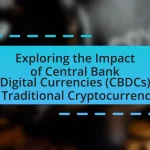Non-Fungible Tokens (NFTs) are unique digital assets verified through blockchain technology, representing ownership of specific items such as art, music, and virtual real estate. This article analyzes the significance of NFTs in the cryptocurrency market, highlighting their distinct characteristics compared to traditional cryptocurrencies, the factors driving their rise, and the impact of digital art and social media on their popularity. It also addresses challenges such as environmental concerns and legal issues, while exploring emerging trends and future prospects for NFTs within the broader cryptocurrency ecosystem. Key platforms facilitating NFT transactions and strategies for investors navigating this evolving market are also discussed.
What are Non-Fungible Tokens (NFTs) and their significance in the Cryptocurrency Market?
Non-Fungible Tokens (NFTs) are unique digital assets verified using blockchain technology, representing ownership of specific items or content, such as art, music, or virtual real estate. Their significance in the cryptocurrency market lies in their ability to create scarcity and provenance for digital goods, enabling artists and creators to monetize their work directly. The NFT market surged in 2021, with sales reaching approximately $25 billion, illustrating their growing impact and acceptance within the broader cryptocurrency ecosystem.
How do NFTs differ from traditional cryptocurrencies?
NFTs, or Non-Fungible Tokens, differ from traditional cryptocurrencies primarily in their fungibility; NFTs are unique digital assets that represent ownership of a specific item or piece of content, while traditional cryptocurrencies like Bitcoin or Ethereum are fungible and can be exchanged on a one-to-one basis. This uniqueness of NFTs is established through blockchain technology, which verifies their distinct properties and ownership, making them suitable for representing art, collectibles, and other individual assets. In contrast, traditional cryptocurrencies serve as a medium of exchange or store of value, where each unit is interchangeable with another unit of the same cryptocurrency.
What characteristics define NFTs?
NFTs are defined by their uniqueness, indivisibility, and ownership verification through blockchain technology. Each NFT possesses distinct metadata and attributes that differentiate it from other tokens, making it one-of-a-kind. Unlike cryptocurrencies such as Bitcoin, which are fungible and can be exchanged on a one-to-one basis, NFTs cannot be divided into smaller units, ensuring that each token represents a singular asset. Furthermore, the blockchain serves as a decentralized ledger that confirms ownership and provenance, providing transparency and security in transactions. This combination of characteristics enables NFTs to represent digital art, collectibles, and other unique items in a verifiable manner.
Why are NFTs considered unique assets?
NFTs are considered unique assets because they are built on blockchain technology, which ensures that each token has a distinct identifier that cannot be replicated. This uniqueness is further reinforced by the fact that NFTs can represent ownership of specific digital or physical items, such as art, music, or collectibles, making them non-fungible, unlike cryptocurrencies like Bitcoin, which are interchangeable. The blockchain records the provenance and ownership history of each NFT, providing verifiable proof of authenticity and scarcity, which are key factors in their valuation and uniqueness in the market.
What factors have contributed to the rise of NFTs?
The rise of NFTs has been primarily driven by the increasing interest in digital ownership and the unique value proposition they offer. The proliferation of blockchain technology has enabled secure and verifiable ownership of digital assets, making NFTs appealing to artists, collectors, and investors. Additionally, the growing popularity of digital art and collectibles, exemplified by high-profile sales such as Beeple’s “Everydays: The First 5000 Days” auctioned for $69 million, has further fueled market interest. The engagement of celebrities and brands in the NFT space has also contributed to mainstream awareness and adoption, creating a cultural phenomenon around digital assets.
How has the popularity of digital art influenced NFT growth?
The popularity of digital art has significantly accelerated NFT growth by creating a high demand for unique digital assets. As artists and creators increasingly embrace digital mediums, platforms like OpenSea and Rarible have emerged, facilitating the buying and selling of NFTs tied to digital artworks. In 2021, the NFT market surged to approximately $41 billion in sales, largely driven by digital art sales, which accounted for a substantial portion of transactions. This trend illustrates how the intersection of digital art and blockchain technology has fostered a new marketplace, attracting both collectors and investors, thereby propelling the overall growth of NFTs.
What role do social media and influencers play in promoting NFTs?
Social media and influencers play a crucial role in promoting NFTs by leveraging their large followings to create awareness and drive engagement. Influencers often showcase NFT projects through posts, videos, and live streams, which can significantly increase visibility and interest among their audience. For instance, when high-profile influencers like Gary Vaynerchuk or Paris Hilton promote specific NFTs, it can lead to substantial spikes in sales and market activity, as evidenced by the rapid growth of platforms like OpenSea following influencer endorsements. This dynamic illustrates how social media serves as a powerful marketing tool, enabling NFT creators to reach broader audiences and enhance the perceived value of their digital assets.
What challenges and criticisms do NFTs face in the market?
NFTs face significant challenges and criticisms primarily related to environmental concerns, market volatility, and issues of copyright infringement. The energy consumption associated with blockchain technology, particularly proof-of-work systems, has raised alarms about the carbon footprint of NFT transactions; for instance, a single Ethereum transaction can emit as much carbon as an average car does in a week. Additionally, the NFT market is characterized by extreme price fluctuations, which can lead to financial losses for investors and create a perception of NFTs as speculative assets rather than stable investments. Furthermore, the potential for copyright infringement is a critical issue, as artists and creators may find their work tokenized and sold without their consent, leading to legal disputes and ethical dilemmas within the market.
How do environmental concerns impact the perception of NFTs?
Environmental concerns significantly impact the perception of NFTs by raising awareness about their carbon footprint, particularly due to the energy-intensive processes involved in blockchain transactions. The Ethereum blockchain, which hosts a majority of NFTs, has been criticized for its high energy consumption, with estimates suggesting that a single transaction can emit as much carbon as an average U.S. household does in a week. This environmental impact has led to a growing skepticism among potential buyers and artists, who may hesitate to engage with NFTs due to ethical considerations regarding sustainability. Consequently, many in the NFT community are exploring alternative, less energy-consuming blockchain technologies, such as those utilizing proof-of-stake mechanisms, to mitigate these concerns and improve public perception.
What are the legal and regulatory issues surrounding NFTs?
The legal and regulatory issues surrounding NFTs primarily involve intellectual property rights, securities regulations, and consumer protection laws. Intellectual property concerns arise when NFTs represent copyrighted works, leading to potential infringement if the creator does not hold the rights to the underlying content. Securities regulations come into play when NFTs are marketed as investment opportunities, which may classify them as securities under laws such as the Securities Act of 1933, requiring compliance with registration and disclosure requirements. Additionally, consumer protection laws address issues related to fraud, misrepresentation, and the rights of buyers in the NFT marketplace, as seen in cases where buyers are misled about the ownership or value of an NFT. These complexities highlight the need for clear regulatory frameworks to govern the NFT space effectively.
How do NFTs impact the broader cryptocurrency ecosystem?
NFTs significantly impact the broader cryptocurrency ecosystem by driving innovation, increasing market participation, and enhancing the utility of blockchain technology. They create new use cases for cryptocurrencies beyond simple transactions, such as digital ownership and provenance verification. The NFT market has attracted diverse participants, including artists, gamers, and collectors, which has led to increased trading volumes and market capitalization within the cryptocurrency space. For instance, in 2021, the NFT market reached a valuation of approximately $41 billion, showcasing its rapid growth and influence. This surge has also prompted established platforms and new projects to integrate NFT functionalities, further solidifying their role in the cryptocurrency ecosystem.
What trends are emerging in the NFT market?
Emerging trends in the NFT market include increased utility beyond digital art, such as integration with gaming and virtual reality, and the rise of fractional ownership, allowing multiple investors to own a share of high-value NFTs. Additionally, there is a growing focus on sustainability, with platforms adopting eco-friendly practices to address environmental concerns associated with blockchain technology. According to a report by NonFungible.com, the NFT market saw a significant increase in sales volume, reaching over $10 billion in the third quarter of 2021, indicating robust growth and interest in diverse applications of NFTs.
What are the different types of NFTs available?
The different types of NFTs available include art, music, virtual real estate, collectibles, and gaming items. Art NFTs represent digital artwork and have gained significant popularity, with platforms like OpenSea facilitating their sale. Music NFTs allow artists to tokenize their music, providing unique ownership experiences for fans. Virtual real estate NFTs represent ownership of digital land or properties in virtual worlds, such as Decentraland. Collectibles NFTs encompass a wide range of digital items, including trading cards and virtual pets, often featuring limited editions. Gaming items NFTs provide players with ownership of in-game assets, enhancing the gaming experience by allowing players to trade or sell their items.
How are NFTs categorized based on their use cases?
NFTs are categorized based on their use cases into several distinct types: digital art, collectibles, gaming assets, virtual real estate, and utility tokens. Digital art NFTs represent ownership of unique artworks, allowing artists to monetize their creations directly. Collectibles, such as trading cards or virtual memorabilia, enable users to buy, sell, and trade unique items, often with a focus on rarity and community engagement. Gaming assets include in-game items that players can own, trade, or sell, enhancing the gaming experience and providing real-world value. Virtual real estate NFTs represent ownership of digital land or properties within virtual worlds, allowing users to develop or monetize these spaces. Lastly, utility tokens provide access to specific services or functionalities within a platform, often incentivizing user engagement and participation. This categorization reflects the diverse applications of NFTs across various sectors, highlighting their growing significance in the digital economy.
What are the most popular types of NFTs in the market?
The most popular types of NFTs in the market include digital art, collectibles, virtual real estate, and gaming items. Digital art has gained significant traction, with platforms like OpenSea and Rarible facilitating high-profile sales, such as Beeple’s “Everydays: The First 5000 Days,” which sold for $69 million in March 2021. Collectibles, particularly those from projects like CryptoPunks and Bored Ape Yacht Club, have also seen immense popularity, with some individual NFTs fetching millions. Virtual real estate in metaverse platforms like Decentraland and The Sandbox allows users to buy, sell, and develop digital land, further driving interest. Additionally, gaming items, such as skins and in-game assets, have become valuable NFTs, with games like Axie Infinity leading the way in integrating blockchain technology into gaming.
How do utility NFTs differ from collectible NFTs?
Utility NFTs provide specific functionalities or access to services, while collectible NFTs primarily serve as digital assets for ownership and aesthetic appreciation. Utility NFTs often grant holders benefits such as exclusive content, membership rights, or participation in events, which enhances their practical value. In contrast, collectible NFTs focus on rarity and artistic value, appealing to collectors and investors without inherent functional benefits. For example, a utility NFT might allow access to a virtual concert, whereas a collectible NFT could be a digital artwork valued for its uniqueness.
What platforms are leading the NFT marketplace?
The leading platforms in the NFT marketplace are OpenSea, Rarible, and Foundation. OpenSea is the largest NFT marketplace, boasting over 1 million active users and facilitating billions in sales since its launch in 2017. Rarible is notable for its decentralized governance model, allowing users to vote on platform changes, and has seen significant trading volume. Foundation focuses on high-quality art and has gained popularity among artists and collectors, emphasizing community and exclusivity. These platforms dominate due to their user bases, unique features, and the volume of transactions they handle.
How do these platforms facilitate NFT transactions?
NFT platforms facilitate transactions by providing a marketplace where users can buy, sell, and trade non-fungible tokens securely. These platforms utilize blockchain technology to ensure transparency and authenticity, allowing users to verify ownership and provenance of NFTs. For instance, Ethereum-based platforms like OpenSea and Rarible enable users to create, list, and purchase NFTs using smart contracts, which automate the transaction process and reduce the need for intermediaries. This decentralized approach not only enhances security but also lowers transaction costs, making NFT trading more accessible.
What features make certain platforms more appealing to users?
Certain platforms are more appealing to users due to features such as user-friendly interfaces, robust security measures, diverse asset offerings, and strong community engagement. User-friendly interfaces simplify navigation and enhance the overall experience, making it easier for both novice and experienced users to interact with the platform. Robust security measures, including two-factor authentication and encryption, build trust and protect users’ assets, which is crucial in the cryptocurrency market. Diverse asset offerings attract a wider audience by allowing users to explore various NFTs and cryptocurrencies, catering to different interests and investment strategies. Strong community engagement fosters a sense of belonging and encourages user participation, which can lead to increased platform loyalty and activity. These features collectively contribute to a platform’s attractiveness, as evidenced by the success of platforms like OpenSea and Rarible, which have capitalized on these elements to grow their user bases significantly.
What are the future prospects for NFTs in the cryptocurrency market?
The future prospects for NFTs in the cryptocurrency market are promising, driven by increasing adoption across various sectors such as art, gaming, and real estate. As of 2023, the NFT market has shown resilience, with sales reaching approximately $24.7 billion in 2021, indicating strong consumer interest and investment potential. Furthermore, major brands and platforms are integrating NFTs into their ecosystems, enhancing their utility and value. For instance, companies like Adidas and Nike have launched NFT collections, showcasing their commitment to this technology. This trend suggests that NFTs will continue to evolve, potentially leading to greater mainstream acceptance and innovative applications in digital ownership and identity verification.
How might technological advancements shape the future of NFTs?
Technological advancements will significantly shape the future of NFTs by enhancing their functionality, interoperability, and user experience. Innovations such as improved blockchain scalability will allow for faster transactions and lower fees, making NFTs more accessible to a broader audience. Additionally, advancements in smart contract technology will enable more complex and customizable NFT features, such as fractional ownership and dynamic content updates. For instance, Ethereum’s transition to a proof-of-stake model aims to increase transaction speed and reduce energy consumption, directly benefiting NFT platforms. Furthermore, the integration of augmented reality (AR) and virtual reality (VR) technologies will create immersive experiences for NFT holders, expanding their utility beyond mere digital ownership. These developments indicate a trend toward a more robust and versatile NFT ecosystem, driven by ongoing technological progress.
What innovations are being developed to enhance NFT functionality?
Innovations being developed to enhance NFT functionality include interoperability, fractional ownership, and dynamic NFTs. Interoperability allows NFTs to be used across different platforms and ecosystems, increasing their utility and market reach. Fractional ownership enables multiple users to own a share of a single NFT, making high-value assets more accessible and promoting liquidity. Dynamic NFTs can change their attributes or appearance based on external data or user interactions, adding a layer of engagement and personalization. These advancements are supported by ongoing developments in blockchain technology and smart contracts, which facilitate these enhanced functionalities.
How could interoperability between blockchains affect NFT growth?
Interoperability between blockchains could significantly enhance NFT growth by enabling seamless transfer and interaction of NFTs across different platforms. This capability allows users to access a broader market, increasing liquidity and demand for NFTs, as assets can be traded or utilized in various ecosystems. For instance, projects like Polkadot and Cosmos are designed to facilitate cross-chain communication, which can lead to a more interconnected NFT marketplace. As a result, the potential for collaboration among creators, collectors, and platforms increases, driving innovation and expanding the user base, ultimately contributing to the overall growth of the NFT sector.
What strategies can investors use to navigate the NFT market?
Investors can navigate the NFT market by conducting thorough research, diversifying their portfolios, and focusing on community engagement. Conducting thorough research involves analyzing market trends, understanding the underlying technology, and evaluating the potential of specific NFTs based on their rarity and utility. Diversifying portfolios helps mitigate risks associated with the volatility of the NFT market, as investing in various types of NFTs—such as art, music, and virtual real estate—can provide a buffer against market fluctuations. Additionally, engaging with communities on platforms like Discord and Twitter allows investors to gain insights, discover emerging projects, and connect with creators, which can lead to informed investment decisions. These strategies are supported by the rapid growth of the NFT market, which reached a valuation of over $41 billion in 2021, indicating significant investment opportunities.
What are the best practices for buying and selling NFTs?
The best practices for buying and selling NFTs include conducting thorough research, verifying the authenticity of the NFT, and understanding the market trends. Buyers should investigate the creator’s reputation, the NFT’s history, and the platform’s security features to ensure a safe transaction. Sellers should provide clear descriptions and provenance of their NFTs, set realistic pricing based on market analysis, and utilize reputable marketplaces to reach potential buyers. According to a report by NonFungible.com, the NFT market saw a significant increase in sales volume, highlighting the importance of informed decision-making in this rapidly evolving space.
How can investors assess the value of an NFT before purchase?
Investors can assess the value of an NFT before purchase by analyzing its rarity, provenance, and market demand. Rarity refers to the uniqueness of the NFT, which can be determined by the total supply and the characteristics that distinguish it from others. Provenance involves examining the ownership history and authenticity of the NFT, as verified ownership can significantly enhance its value. Market demand can be gauged by looking at recent sales data, trends in the NFT marketplace, and the popularity of the creator or brand associated with the NFT. For instance, NFTs from well-known artists or brands often command higher prices due to established demand.





